| Much Adu about Apple Pie, Pilgrimage to Jomosom Day
2: Trek to Jharkot (5.5 hrs) and a visit to Muktinath (1 hr up, 30 min
down)
The guys and I started the day
bright and early with a breakfast of ramen noodle soup, while Ken and
Lisa partook of the more conventional eggs and apple porridge. I guess I
had become so accustomed to eating in the Nepali style, that the new
wealth of food options surprisingly didn't tempt me. We packed up and
headed out. Kagbeni lay at the bottom of large gorge leading up into
Muktinath. Our trail to the top of the plateau was a perfect 30 degree
incline, and we could see the ant-like figures of a long trekking congo
line making its way up the smooth path. We grabbed on and took off.
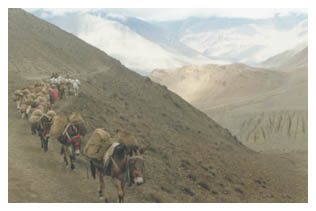
We danced alongside laden donkey
trains bringing provisions to the upper villages. Our music was the
tinkling of the bells on the lead donkey. As we ascended, climbing from
the 2810m of Kagbeni up to the 3500m of Jharkot, the air actually felt
thinner and very crisp. We practiced throwing stones, trying to make
them roll all the way down the canyon. The perfect 30 degree incline
foiled us every time, as the stones inevitably coming to a halt under
some scrubby brush that was poked and prodded by the few goat herds up
here. Once the hard core trekkers pulled ahead, we settled into a nice,
even pace, Ken and Lisa working their hi-tech trekking poles like a
metronome. We met many Nepalis coming from all over to make the
pilgrimage to Muktinath. It was an auspicious time, Nepali New Year's
Eve, and we passed both sadhus and families making their way to pray at
the famous and holy temple.
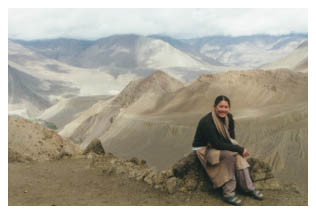
The desert landscape around us
became increasingly surreal, more painted backdrop than reality. The
sunlight was playing tricks with my eyes at this altitude. It was
beautiful, tranquil and otherworldly.
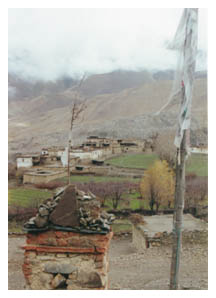
As
we closed in on Jharkot, the landscape was transformed again at the
hands of generations of enterprising Nepalis determined to make the
desert bloom. Crop fields sprung up cordoned off neatly by trim stone
walls and traditional mud homes dotted the hillside. Out trail was
continously marked by chautaras, stone platforms around trees or mud and
stone stupas which give rest to weary pilgrims.
To build one is to accumulate
much karma. To sit on one is to feel immense relief.
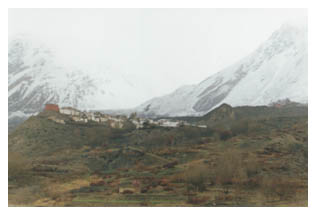
Jharkot loomed above us like an
ancient fortress, cradled by the surrounding mountains. It was imposing,
the walls rising up, covered in hundreds of years of time and soot. At
the closer end, the distinctive shape of a monestary could be made out,
a solid trapizoidal shape, dusty red with no outwardly facing windows,
nothing to break the surface and straight out of the Middle Ages.
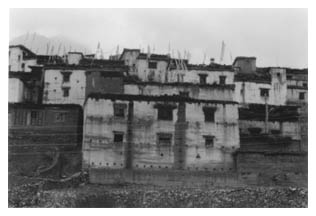
From the
rooftops, tall poles reached to the sky, festooned with prayer flags
bleached white by the sun. In fact, all color seemed to be drained from
the scene. Instead the fortress of Jharkot was rendered in varying shades
of grey and muted browns. We walked into the village through a small
gateway and headed to one of the four lodges there and collapsed. Hungry
and tired, we summoned whatever the kitchen had on hand, cooked and ready
to go for a late lunch. Surprise, surprise, dhal bhat. Gaining a second
wind, we headed out, might lighter this time for out gear was stowed in
our rooms and made the one hour trek up to Muktinath. Prakash and Deepak
quickly trekked ahead, lightened by the unburdening of their load and we
followed behind, jelly legs weary and weak by the mornings exercise.
Entering Muktinath under the newly built gate, we were first greeted by
the rough cluster of lodges geared towards trekkers. Continuing on past
the pleas of Nepali women hawking souvenirs of Tibetan jewelry and a
unique weaving indigenous to the area, we continued up to the actual
Temple of Muktinath situated higher up the mountainside. The day had gone
from sunny to dank and grey, reflecting the limited color palette of the
area. Now ascending past 3800 m, we crossed the snowline. It was misty and
the air was thick with humidity. The rain just hung there, like it was
trying to decide if it was actually snow.
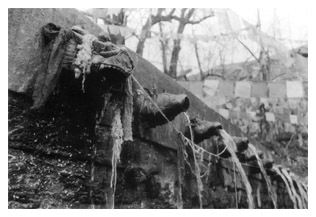
The Vishnu temple of
Jiwala Mayi is standard Hindu tiered temple architecture. The small
courtyard building was itself centered in a larger courtyard surrounded by
a tall stone wall with one hundred carved stone animal heads pouring forth
the sacred water. The guys and I circumambulated the perimeter, passing
our hand under each fountain to ritually catch some water, sip it and then
toss it over our heads. Then we entered the temple compound and received
tika blessing, a rice and red powder mixture, by the priests there.
Non-Hindus are allowed into the compound, but not into the central
sanctuary, but don't forget to remove your shoes when you enter. From
there, we headed over to the Buddhist gompa, passing through a field of
stone stupas, some as large as we were, others, just a few stones piled
up.
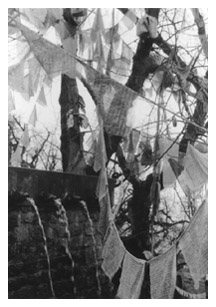 The Buddhist gompa includes a small temple that protects Muktinath's
famous eternal flame. The temple is maintained by a small group of
Buddhist nuns who showed us around. Taking off our shoes, we made our way
forward toward the alter. There, we each kneeled down, alternately praying
and peering at the natural gas jets that sprung out from the hidden spring
under the alter. It's that special combination of earth, water and fire
that gives Muktinath it's great religious significance. The Buddhist gompa includes a small temple that protects Muktinath's
famous eternal flame. The temple is maintained by a small group of
Buddhist nuns who showed us around. Taking off our shoes, we made our way
forward toward the alter. There, we each kneeled down, alternately praying
and peering at the natural gas jets that sprung out from the hidden spring
under the alter. It's that special combination of earth, water and fire
that gives Muktinath it's great religious significance.
Before heading back to
Jharkot for the evening, we stopped at the equally famous Bob Marley Lodge
and relaxed. While the Muktinath temple complex itself was wonderful to
see, the lodging area of Muktinath is disappointing. A depressing cluster
of ram-shackle lodges seemingly built as fast as possible out of as cheap
materials as possible, it had nothing on Jharkot aside from the reggae
stylings of No Women, No Cry. I would recommend to everyone to make
Muktinath a side-trek and stay instead at Jharkot, a far more interesting
and unique place to hole up. Plus, you get the added advantage of climbing
high and sleeping low, the anti-altitude sickness mantra. We returned to
the Sonny Lodge in Jharkot and rewarded ourselves with pizza and card
games.
Jharkot itself is
fascinating. Wandering through the narrow lanes transports you to another
time, and it is even less developed than Kagbeni if that's possible.
Tucked away in this remote corner, Jharkot feels as though nothing has
changes for thousands of years. Many walls were crumbling from the ravages
of time, but people continue to make their homes among them. The monestary
at the far end is over five hundred years old, and its temple houses a
series of blackened murals just as old. Ask someone to lit a lamp and be
sure to leave a donation to help maintain it. Also at the monestary is a
traditional Tibetan medicinal center devoted to collecting and researching
plants and herbs. The monks there hold a wealth of knowledge and like to
chat. Or you can just play with the young monks. All in all, taking out
some time to savor the charms of Jharkot and the people who call it home
is a highlight of the trek.
next
| Day 2 |
back
|
